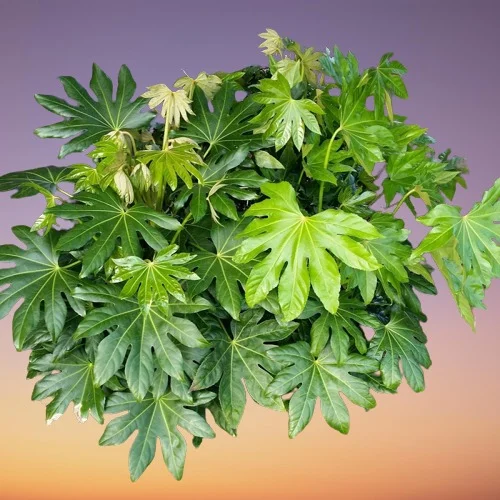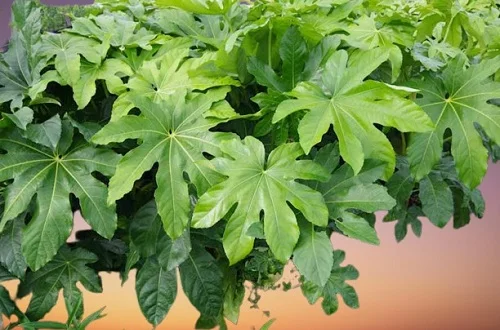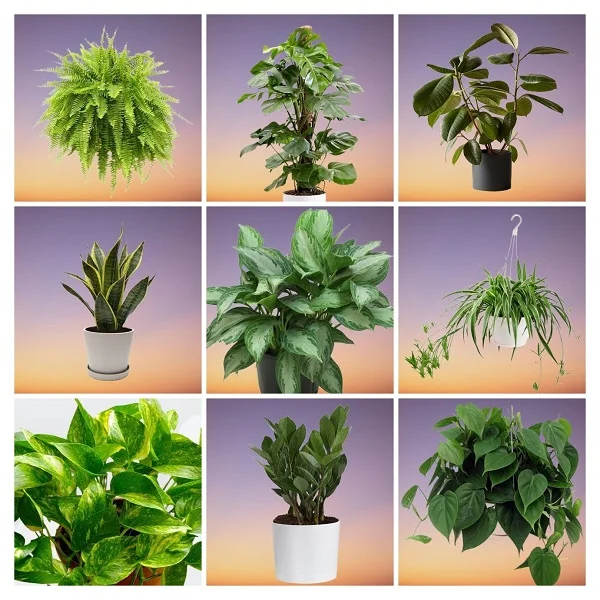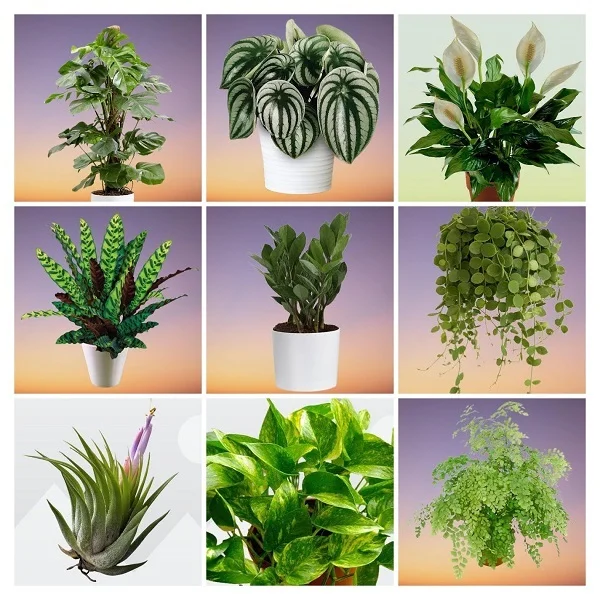Fatsia japonica (Japanese Aralia) Care Indoors, Propagation, Common Problems & Fixes
Some links in this post may be affiliate links
Fatsia japonica (Japanese Aralia) prospers in medium to bright indirect light, average warmth, moderate humidity and moderately moist, rich, well-drained, all purpose soil coupled with monthly feeding in the growing season.
Japanese Aralia is often grown as an outdoor shrub, but it can also be a fantastic indoor houseplant if given the right care. In this guide we discuss everything you need to know to keep this eye-catching plant happy and thriving in your home.
Let's dig into some facts about this lush, tropical plant. Fatsia japonica, also called Paperplant or Glossy-leaf Paper Plant is one of the popular hardy plants which can withstand a wide range of conditions and is ideal for beginners and seasoned plant parents too.
The botanical name "Fatsia" is an approximation of the Japanese word for 'eight' in reference to the eight leaf lobes. The leaves are large, deeply lobed and leathery in texture.

Botanical name: Fatsia japonica
Family: Araliaceae
Common names: Japanese Aralia, Paperplant, Glossy-leaf Paper Plant
Origin
Fatsia japonica is native to the tropical regions of southern Japan, southern Korea and Taiwan. Several cultivars of Fatsia japonica have been developed.
Size
Japanese Aralia Plant is an excellent stand alone plant, growing to a height of 4 feet or more. The leaves are spirally-arranged and large about 8-16 inches in width and makes this plant one of the best large-leafed plants for the large spaces.
Air Purifying
Japanese Aralia has been shown to be a good indoor air cleaner, where it effectively removes formaldehyde and benzene from indoor air.
Varieties
One of the recognized cultivars is Fatsia japonica Variegata commonly called Spider's Web or Spider White which bears variegated leaves. Fatsia japonica has been interbred with Hedera helix (English Ivy) to produce the hybrid xFatshedera lizei (Tree Ivy).
Is Fatsia japonica toxic to pets?
Fatsia japonica is non-toxic to both humans and pets as indicated by ASPCA. Japanese Aralia is not toxic to dogs and cats. However, it produces a sticky and resinous sap which has been found to cause contact dermatitis in sensitive skin.
Fatsia japonica benefits
- Low-maintenance: It thrives with minimal care once established.
- Fast-growing & hardy: It can grow 3–6 feet tall indoors with proper care.
- Shade-tolerant: It is one of the best large plants for lower light conditions.
- Large, bold foliage: The big, glossy, hand-shaped leaves create a stunning tropical look.
- Air-purifying: It helps filter toxins like formaldehyde and benzene from indoor air.
Where to Buy
If you are looking to add Fatsia japonica plants to your collection, you may acquire the plants online from Etsy (Link to Etsy).
Fatsia japonica Care Indoors
Now let's dive into caring for Fatsia japonica indoors. Japanese Aralia blossoms in medium to bright indirect light, average warmth of 15-26, moderate humidity of 50-55% and moderately moist, fertile, well-drained, all purpose soil coupled with monthly feeding during the growing season.
Fatsia japonica care requires regular pruning and grooming to keep the plant neat and thriving. Repotting is needed every 2 years. Below is a detailed outline of the best growing conditions and how to provide them.

Watering
Water your Fatsia japonica thoroughly during the growing period and allow the top 2-3 inches of soil to dry out between waterings to keep the soil moderately moist. Take care not to overwater to prevent yellowing of leaves.
Reduce watering in the cold season as growth is minimal at this time to keep the soil slightly moist. Never allow the soil to dry out completely to avoid getting droopy leaves.
Make sure that the pot has a draiange hole to prevent the soil from getting soggy as it can lead to root-rot and eventual death of the plant.
Light Requirements
Japanese Aralia Plant grows best in medium to bright indirect light. Keep it away from direct sunlight as it may cause fading and scorching, resulting in brown marks on the leaves.
Paperplant is very tolerant and will tolerate lower light conditions but it will grow more slowly. It is considered as one of the best large low light plants for the living room.
However, too little light will cause the plant to become leggy with sparse growth. Move it to a brighter spot or use a grow light if the natural lighting is not enough.
Regularly rotate the pot to ensure that the plant receives light on all sides for uniform growth to prevent unbalanced growth.
Temperature and Humidity
Average warmth of 15-260C is ideal for Japanese Aralia Plant. The plant prefers relatively warm temperatures during the growing season followed by a relatively cold season. Avoid placing it near cold drafts, air conditioners, or heating vents, as they can dry out the leaves.
Fatsia japonica Plant has no need for high humidity. Average room humidity of 50-55% is ideal for this plant though it can withstand dry air.
Nonetheless, very low humidity may result in brown, crispy leaf tips and edges. To up scale humidity, set the pot on a wet pebble tray or use a cool mist humidifier.
Potting Mix
Japanese Aralia Plant soil should be a well-draining, nutrient-rich soil mix. Most all purpose potting mixes are ideal for this plant. You may choose from these 16 potting mixes for indoor plants.
Fertilizer
Feed Fatsia japonica with a balanced, liquid fertilizer once every month during the growing season for lush growth. Avoid too much fertilizer as it can result in leggy growth.
Do not feed in the cold season as growth is reduced and feeding at this time can cause fertilizer burn and death of the plant.
Dry, brown-black leaf tips and a white crust on the soil surface are an indication of a build up of salts and chemicals in the soil. Every 2-3 months flush out accumulated salts by running a stream of water through the soil until it drips through the drainage holes. Allow it to run for 5-10 minutes.
Repotting
Repot the young Japanese Aralia Plant annually and the mature plants every two years. The best time to repot is at the beginning of the growing period.
Use a pot 1 size larger and free-draining soil that is rich in organic matter. Ensure the pot has a drainage hole to prevent the soil from getting soggy as it can lead to root-rot. Check out these ceramic pots with drainage holes on Amazon.
Pruning & Grooming
Prune Fatsia japonica at the beginning of the growing season. Cutback the foliage with a sharp, clean pair of pruning scissors to a few inches above the soil level to rejuvenate growth and achieve a more compact, bushy plant. The foliage emanating from the pruning can be used to take stem cuttings for propagation of new plants.
Mist the leaves frequently and clean them by damp-wiping with a soft cloth for photosynthesis as well as discourage pests and diseases.
Fatsia japonica Propagation
Japanese Aralia propagation can be done from seeds or from stem cuttings. Rarely will the plant flower or produce seeds when grown indoors. Propagation by stem cuttings therefore becomes the best option.
1. Japanese Aralia propagation from stem cuttings in soil
- Take a stem cutting of about 3-4 inches long from a healthy plant. Make sure it bears at least 2-3 leaf nodes and one set of leaves.
- Remove the bottom leaves, leaving only the top ones.
- Dip the cut end of the cutting in a rooting hormone to hasten rooting.
- Fill the rooting container with loose, well-drained potting mix.
- Moisten the soil and make a hole in the center.
- Carefully, while avoiding rubbing off the rooting hormone, insert 2 inches of the cutting in the hole previously made.
- Lightly firm the soil around the cutting to keep it upright.
- Place the set up in a warm humid place under bright indirect light until new growth appears which indicates rooting and should occur in 4–6 weeks.
- Once the new plant has established, transplant it into a slightly larger pot after which, you may begin the normal routine care.
2. Japanese Aralia propagation from stem cuttings in water
- With a sharp clean pruning scissors, take a 3-4 inches long stem cutting from a healthy plant. Ensure it bears at least 2-3 leaf nodes and one set of leaves.
- Strip off the bottom leaves, leaving the top ones only.
- Coat the cut end of the cutting with a rooting hormone to encourage rooting.
- Place the cutting in a jar of plain water or in a propagation station, ensure at least one leaf node is covered in water.
- Change the water every 5-7 days to prevent bacterial and fungal growth.
- Position the set up in a warm, well-lit spot until it is well rooted. Roots will develop in 4–6 weeks.
- When the roots are about 2-3 inches long, transfer the cutting into a small pot in free-draining soil.
- Keep the soil slightly moist until the plant is well established.
- Transfer the new plant into a pot one size larger than the current one in well-draining soil and begin routine care.

Fatsia japonica Problems Indoors with Solutions
Fatsia japonica (Japanese Aralia) problems indoors are brown leaves, yellow leaves, drooping leaves, leggy growth, pests and diseases among others. Keep reading for more on these problems, their remedies and solutions.
Brown, shrivelled leaves
One cause of brown shrivelled leaves in Fatsia japonica is exposure to too hot sunshine. Shield the plant from hot sun or move it a shadier spot.
The second cause of brown shrivelled leaves in Japanese Aralia Plant is too dry air. Set the pot on a wet pebble tray or use a cool mist humidifier to elevate humidity.
Brown, brittle leaf edges
Brown, brittle leaf edges in Fatsia japonica are caused by underwatering. Water the plant liberally and keep the soil moderately moist in the growing season. Maintain the soil slightly moist in the cold season but never allow the soil to be completely dry.
Yellow leaves
One of the causes of yellow leaves in Fatsia japonica is overwatering if the leaves of are wilted and soft. Ascertain that the soil is free-draining, the pot has a drainage hole and allow the soil to dry out between waterings.
The second causes of yellow leaves in Japanese Aralia is too much heat if the leaves are brittle. Keep the plant away from hot drafts and maintain an average warmth of 15-260C. A temperature that is comfortable for a you is ideal for the plant. Check out this guide on understanding temperature for houseplants.
Drooping leaves
One possible cause of drooping leaves in Fatsia japonica is underwatering. Water when the top 2-3 inches of soil dry out. Do not allow it to dry out completely for a prolonged period.
The second possible cause of drooping leaves in Japanese Aralia is extremely low or high temperatures. Keep the plant away from drafts emanating from hot stoves, air conditioning units, windy doors, drafty windows and other.
Pests
Common pests in Japanese Aralia are mealy bugs, scales, aphids and whiteflies. Isolate the affected plant to prevent spread to other plants and treat it with neem oil or insecticidal soap as per the manufacturer's recommendations. Regularly check the undersides of leaves for pests and wipe them clean.
Leggy growth
One cause of leggy growth in Fatsia japonica is too little light. Move the plant to a brighter spot or instal a grow light if the natural light is not sufficient.
The second cause of leggy growth in Japanese Aralia is overfeeding. This plant is not a heavy feeder. Fertilize it monthly but do not feed in the cold season.
Pale and spotted leaves
Pale and spotted leaves in Fatsia japonica are due to underwatering. Water the plant when the top 2-3 inches of soil to dry out. Cut down on watering in the cold season but never allow the soil to dry out completely. Read more on how to water houseplants the correctly.
Conclusion
Japanese Aralia (Fatsia japonica) is a bold, beautiful, and easy-care houseplant that thrives indoors with minimal effort. Whether you grow it as a compact tabletop plant or a large statement piece, it will reward you with lush, tropical foliage. By following these care tips, you can enjoy a healthy and thriving Japanese Aralia.
Frequently Asked Questions
1. How much sunlight does Japanese Aralia need?
Japanese Aralia thrives in bright indirect light, but can tolerate partial shade.
2. How often should I water Japanese Aralia?
Water Japanese Aralia when the top 2-3 inches of soil are dry. Do not water on a schedule.
3. Can Japanese Aralia grow in low light?
Yes. Japanese Aralia adapts well to moderate to low light, but grows best in bright indirect light.
4. How fast does Japanese Aralia grow?
Japanese Aralia has a moderate to fast growth rate, reaching 3–6 feet indoors.
5. What is the best fertilizer for Fatsia?
Fatsia does well with a balanced liquid fertilizer applied monthly during the growing period. It is not a heavy feeder, therefore, take care not to overfeed.
6. Why is my Fatsia japonica not doing well?
Your Fatsia japonica may not be doing well due to too little light, underwatering, wrong temperatures, being pot bound, lack of pruning, fertilizer burn, pests, root-rot among others.
7. How can I make Fatsia grow faster?
To make your Fatsia japonica grow faster;
- Give it bright indirect light,
- water it when the top soil dry out,
- maintain an average warmth
- maintain a moderate humidity,
- feed it monthly with a balanced fertilizer,
- pot in well-drained soil,
- use a pot with a drainage hole,
- repot when rootbound,
- cut it back at the beginning of the growing season, and
- control pests and diseases.
8. How do you revive Fatsia japonica?
- Remove the plant from its pot, trim black, mushy roots, and treat the healthy roots with a copper-based fungicidal solution.
- Repot the plant in fresh well-drained soil. Mix perlite or sand into the soil to improve aeration and drainage.
- Use a pot with a drainage hole to prevent the soil from getting overwet.
- Cut down on watering in the cold season to keep the soil barely slightly moist as growth is minimal at this time.
9. Why are my Japanese Aralia leaves turning yellow?
Yellowing is often due to overwatering or poor drainage. Ensure the soil dries slightly between waterings.
10. Why is my Japanese Aralia drooping?
Drooping in Japanses Aralia is caused by underwatering and temperature stress. Water when the top 2-3 inches of soil dry out and keep the plant away from drafts to maintain an average warmth.
You liked it? Share on social media.
Related Content
Amazon Associates Disclosure
Homeplantsguide.com is a participant in the Amazon Services LLC Associates Program, an affiliate advertising program designed to provide a means for sites to earn advertising fees by advertising and linking to amazon.com.





